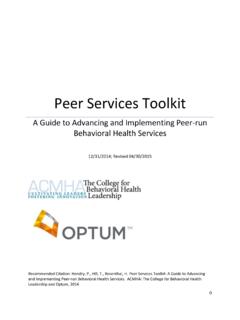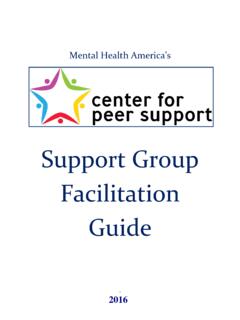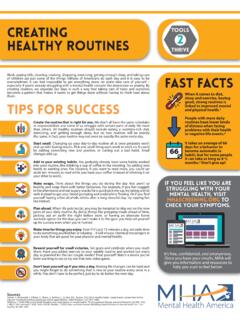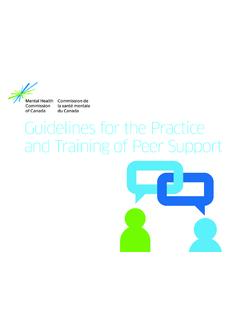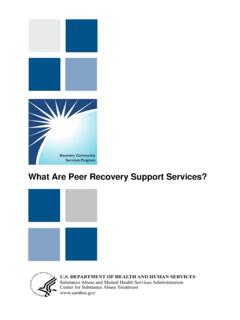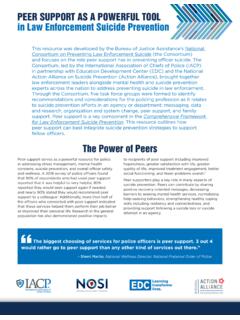Transcription of Evidence for Peer Support May 2018 The Case for Peer …
1 Evidence for peer Support May 2018 The Case for peer Support peer Support is an Evidence -based practice for individuals with mental health conditions or challenges. Both quantitative and qualitative Evidence indicate that peer Support lowers the overall cost of mental health services by reducing re-hospitalization rates and days spent in inpatient services, increasing the use of outpatient services. peer Support improves quality of life, increases and improves engagement with services, and increases whole health and self-management. This document identifies key outcomes of per Support services over a range of studies differentiated by program, geographic location, and year. Though many of the studies and programs listed below have some major programmatic differences, one thing is the same they all demonstrate the value of peer Support . The Evidence Reduced re-hospitalization rates Recovery Innovations in Arizona saw a 56% reduction in hospital readmission ratesi Pierce County Washington reduced involuntary hospitalization by 32% leading to a savings of million dollars in one yearii Optum Pierce peer Bridger programs served 125 people and had reduction in hospital admission year over year resulting in $550,215 in savings.
2 100% of consumers had been hospitalized prior to having peer coach, only were hospitalized after getting a coach iii Reduced days inpatient Participants assigned a peer mentor had significantly fewer re-hospitalizations & fewer hospital daysiv TN PeerLink program: significant decrease of 90% in average number of acute inpatient days per monthv WI PeerLink Program showed 71% decrease in number of acute inpatient days per monthvi In two of their managed care contracts, Optum saw an average reduction of inpatient days for individuals who had at least two hospitalizations on average per yearvii Lowered overall cost of services A Federally Qualified Health Center in Denver (FQHC) that used peer Support had an ROI of $ for every $1 spent. In a different program, Recovery Mentors provided individualized Support for schizophrenia, depression, bipolar disorder: over 9 months, saw.
3 89 vs. hospitalizations, vs. days in An effort to reduce depression/anxiety disorders in India demonstrated a 30% decrease in prevalence, 36% decrease in suicide attempts, fewer days no work/reduced work in previous 30 days; cost-effective & cost-savingix A 2013 review of determined that the financial benefits of peer Support exceed the costs, in some cases In a 2013 study, of respondents were not employed or had transitional/sheltered employment before CPS training. As a result of their work as CPS, 60% of respondents transitioned off or reduced public assistance and reduced their use of mental health care services. Changes in the respondents mental health service use are outlined below: xi Increased use of outpatient services The following are data indicating the effectiveness of the peer Bridger model created by the New York Association of Psychiatric Rehabilitation Services (NYAPRS).
4 Decrease in number of people who use inpatient services Percentage New York* Wisconsin Decrease in number of inpatient days New York* Wisconsin Increase in number of outpatient visits New York* Wisconsin Decrease in total Behavioral Health Costs New York* Wisconsin * The New York-based outcomes were achieved via the application of the peer Bridger 90% of PEOPLe Inc s Rose House crisis respite program (Orange County, NY) participants did not return to hospital in the following two years, 2010 program evaluation dataxiii Mental Health peer Connection s Life Coaches helped 53% of individuals with employment goals to successfully return to work in the Buffalo, NY area, 2010 program evaluation Western NY s Housing Options Made Easy helped 70% of residents to successfully stay out of hospital in the following year, 2011 program evaluation A Mental Health America and Kaiser Permanente Pilot Study showed an increase in supports for individuals as they transitioned from inpatient settings and increased connection with behavioral health Increased quality of life outcomes Instillation of hope through positive self-disclosure, role modeling self-care of one s illness.
5 Empathy & conditional regard may lead to higher demands/expectations for clientsxvii A meta-analysis showed peer Support is superior to usual care in reducing depressive Individuals receiving peer Support are more likely to have peer Support improves symptoms of depression more than care as A Mental Health America and Kaiser Permanente Pilot Study showed an increased ability to meet participants social needs with interventions in the community and improved ability to address gaps following inpatient services like housing and access to Veterans in a peer -to- peer program had significantly higher senses of empowerment and A metasynthesis showed that those receiving peer Support services had increased social The following table demonstrates the results of a survey regarding the impacts of CPS The following table outlines the outcomes of a variety of peer Support Table 2.
6 Program Description and Outcomes of peer Support Study Program Description Study Participants Outcome peer Employees (Employed Consumers) Solomon & Draine 1994; 1995 [20-22] A randomized trial of a team of case managers who are mental health consumers compared to a team of non-consumers. Recipients of case man- agement (n=94) Case management services delivered by con- sumers were as effective as those provided by non-consumers (symptomatology; QOL; social contacts; medication complia nce; alliances with clie nts). Clients served by a consumer team were less satisfied with mental health treatment. Felton et al. 1995 [23] An intensive case-management program with peer specialis ts. Recipients of case man- agement (n=104) Clients served by teams with peer specialis ts demonstrated greater gains in several areas of QOL and an overall reduction in the number of major life problems experienced.
7 Rivera et al. 2007 [26] Consumer-assisted case management with standard clinic-based care. Recipients of case man- agement or clinic-based care (n=203) There were no significant differences between the consumer-assisted program and other pro- grams in terms of symptoms, satisfaction, sub- jective QOL, objective ratings of contacts with family or friends, and objective ratings of activi- tie s and finances. Lawn et al. 2008 [27] Early discharge and hospita l avoidance Support program provided by peers. Recipients of peer Support (n=49) 300 bed days and costs were saved by the peer service. Sells et al. 2006; 2008 [18, 19] Intensive case-management teams that included peer providers. Recipients of case man- agement (n=137) Partic ipants who received peer -based services felt that their providers communicated in ways that were more validating an d reported more positive provider relationship qualities com- pared with partic ipants in the control condition.
8 Griswold et al. 2010 [25] Trained peers employed by a local community or- ganization provide a variety of services, including connections to social and rehabilitation services, by arranging appointments and providing transport. Recipients of psychiatric emergency care (n=175) Partic ipants with peer Support were significantly more likely to make connections to primary medical care. peer -Led ( peer -Run) Programs Chinman et al. 2001 [15] An outreach and engagement program developed, staffed, and managed entir ely by mental health consumers. Recipients of consumer- run service or outpatie nt service (n=158) Re-hospita lization rate. (No difference between the intervention group and the control group.) Yanos et al. 2001 [28] Programs that are staffed and operated completely by self-described mental health consumers provide services such as self-help, activity groups, and drop- in groups.
9 Recipients of mental health services (n=60) Involvement in self-help services was associated with bette r community adjustment, the use of more coping strategies, and a greater proportion of problem-centered coping strategies. Corri gan 2006 [29] Consumer-operated services. People with psychiatric disability (n=1824) Partic ipation in peer Support was positively correlated with recovery or empowerment fac- tors. Nelson et al. 2007 [30] Consumer / survivor initiatives run by and for peo- ple with mental ill ness. Partic ipants of peer -run organization (n=102) Continuously active partic ipants scored signifi- cantly higher on a measure of community integration than the non-active group. Mutual Help Groups Galanter 1988 [31] Self-help program designed by a psychiatrist to help partic ipants cope with general psychiatric disorders. Partic ipants in self-help group (n=356) A decline was found in both symptoms and concomitant psychiatric treatment after subjects joined the self-help group.
10 Wilson et al. 1999 [3 2] peer group work , including welcoming members, check-i n, group discussion, planning a recreational outing and check-out Parti cipants in pee r Support groups (n=165) Maintained independent or semi-independent li ving, an increa se in the use of community re sources and an increase in the size of the social Support Segal & Silver- man 2002 [33] Self-help agencies that offer mutual Support gro ups, drop-i n space, an d direct serv ice s, including ca se management, peer counseli ng, housing financial benefits job counseling Long-term users of self- help agencies (n =255) The parti cipants showed signifi cant impro ve- ment in personal empowerment, a signifi cant decrea se in assisted social functi oning, and no iifit h i iddt il Bracke et al. 2008 [3 4] peer groups of clients of day-acti vit y programs of rehabilitati on centers fo r persons wit h chronic men- tal healt h problems.

